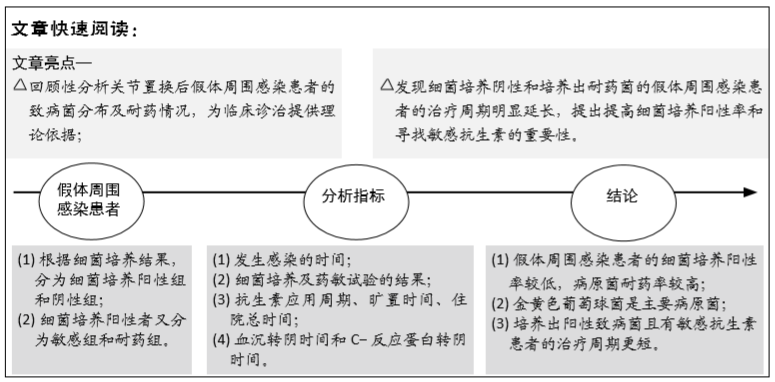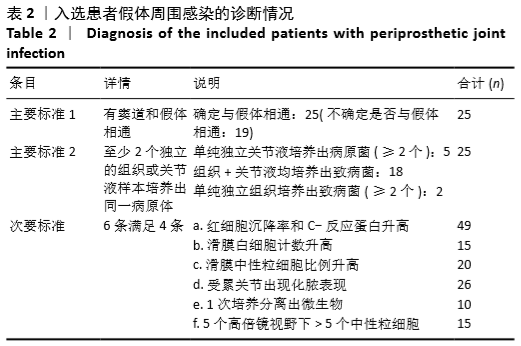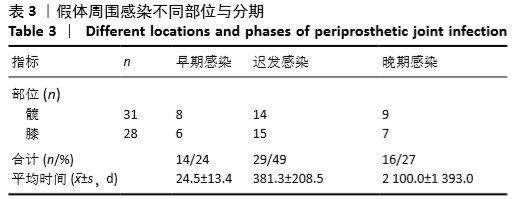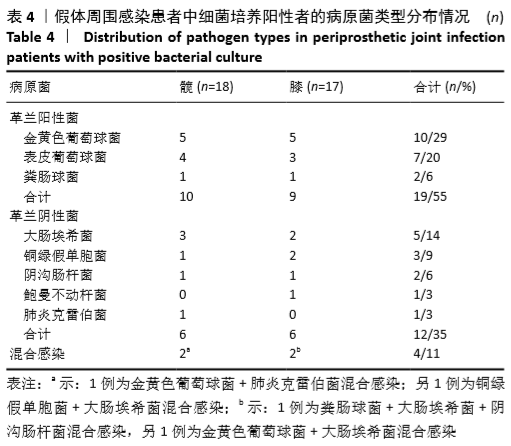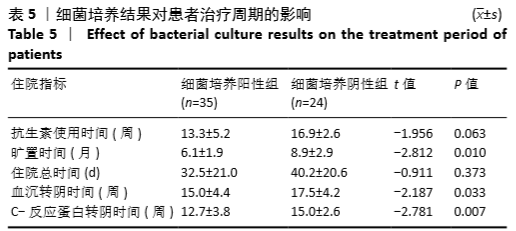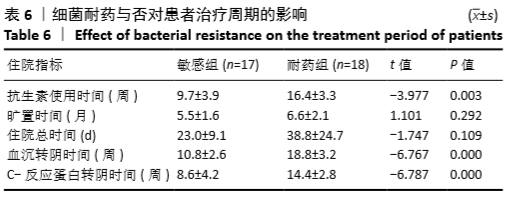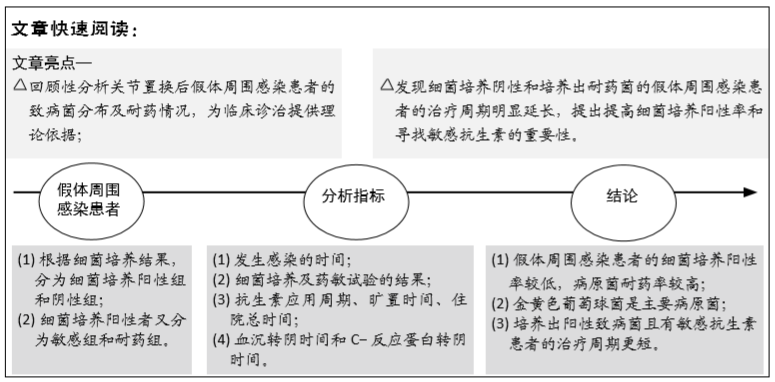[1] Kapadia BH, Berg RA, Daley JA, et al. Periprosthetic joint infection. Lancet. 2016;387(10016):386-394.
[2] Tansey R, Mirza Y, Sukeik M, et al. Definition of Periprosthetic Hip and Knee Joint Infections and the Economic Burden. Open Orthop J. 2016;10(Suppl-2, M9):662-668.
[3] 崔苛苛, 杨伟毅, 刘军, 等. 全膝关节置换后假体周围感染病原菌分布特点及治疗策略[J]. 中国组织工程研究, 2017, 21(35): 5721-5726.
[4] 李静, 张宁, 邵宏翊, 等. 60例人工关节置换术后假体周围感染患者病原学回顾性分析[J]. 临床药物治疗杂志, 2017, 15(6):44-47.
[5] Gellert M, Hardt S, Koder K, et al. Biofilm-active antibiotic treatment improved the outcome of knee periprosthetic joint infection: results from a 6-year prospective cohort. Int J Antimicrob Agents. 2020; 105904.
[6] Tan TL, Kheir MM, Tan DD, et al. Polymicrobial periprosthetic joint infections: outcome of treatment and identification of risk factors. J Bone Joint Surg Am 2016;98(24):2082-2088.
[7] 李超, 尚希福, 曹晓芳, 等. 利福平联合左氧氟沙星预防全髋关节置换后感染[J]. 中国组织工程研究,2014, 18(48):7714-7718.
[8] 钟剑峰, 李干, 陈晓斌, 等. 微生物培养结果对THA术后慢性假体周围感染二期翻修术疗效的影响[J]. 南京医科大学学报(自然科学版),2015,35(9):1262-1267.
[9] 唐浩, 周一新. 假体周围关节感染的新定义—肌肉与骨骼感染协会专家组共识[J]. 中国骨与关节外科, 2013, 6(1):56-57.
[10] Guan H, Xu C, Fu J, et al. Diagnostic criteria of periprosthetic joint infection: a prospective study protocol to validate the feasibility of the 2018 new definition for Chinese patients. BMC Musculoskelet Disord. 2019; 20(1):552.
[11] Zimmerli W, Trampuz A, Ochsner PE. Prosthetic-joint infections. N Engl J Med. 2004; 351(14):1645-1654.
[12] Izakovicova P, Borens O, Trampuz A. Periprosthetic joint infection: current concepts and outlook. EFORT Open Rev. 2019; 4(7): 482-494.
[13] 陈睿,田野,袁文,等.骨科植人物感染的发生及预防的研究进展[J]. 实用骨科杂志,2017,23(12):1095-1098.
[14] Josse J, Valour F, Maali Y, et al. Interaction between staphylococcal biofilm and bone: how does the presence of biofilm promote prosthesis loosening? Front Microbiol. 2019; 10:1602.
[15] Saeed K, McLaren AC, Schwarz EM, et al. 2018 international consensus meeting on musculoskeletal infection: Summary from the biofilm workgroup and consensus on biofilm related musculoskeletal infections. J Orthop Res. 2019; 37(5):1007-1017.
[16] Gandhi R, Silverman E, Courtney PM, et al. How many cultures are necessary to identify pathogens in the management of total hip and knee arthroplasty infections? J Arthroplasty. 2017; 32(9): 2825-2828.
[17] McLawhorn AS, Nawabi DH, Ranawat AS. Management of resistant, atypical and culture-negative periprosthetic joint infections after hip and knee arthroplasty. Open Orthop J. 2016; 10(1):615-632.
[18] 李恒, 杨瑞, 耿磊, 等. 细菌培养阴性的关节假体周围感染的临床特点[J]. 中国修复重建外科杂志,2014,28(1):30-33.
[19] 谭冠中, 刘侃, 陈继营,等. 利多卡因对细菌培养影响的实验研究[J]. 中国矫形外科杂志, 2019,27(14):1302-1305.
[20] Schafer P, Fink B, Sandow D, et al. Prolonged bacterial culture to identify late periprosthetic joint infection: a promising strategy. Clin Infect Dis 2008;47(11):1403-1409.
[21] Tan TL, Kheir MM, Shohat N, et al. Culture-negative periprosthetic joint infection: An update on what to expect. JB JS Open Access. 2018; 3(3):e0060.
[22] Palan J, Nolan C, Sarantos K, et al. Culture-negative periprosthetic joint infections. EFORT Open Rev. 2019; 4(10):585-594.
[23] 李程, Renz N, Trampuz A. 超声裂解法在诊断假体周围感染的应用[J]. 实用骨科杂志, 2019,25(8):724-728.
[24] Zimmerli W, Moser C. Pathogenesis and treatment concepts of orthopaedic biofilm infections . FEMS Immunol Med Microbiol. 2012; 65(2):158-168.
[25] 陈志, 周宗科, 沈彬, 等. 急性、迟发性、慢性假体周围感染的病原学特征及疗效分析[J]. 实用骨科杂志,2019, 25(4):313-316.
[26] 周一逸, 刘仪, 袁鹏, 等. 骨关节置换术后假体周围感染的病原菌特征及影响因素分析[J]. 中华医院感染学杂志, 2019,29(14): 2189-2193.
[27] 陈仁德, 李勇军, 李向平,等. 人工关节置换术后假体周围组织感染的病原菌分布及耐药性分析[J]. 中国骨与关节损伤杂志, 2019,34(10):1022-1025.
[28] Aggarwal VK, Bakhshi H, Ecker NU, et al. Organism profile in periprosthetic joint infection: pathogens differ at two arthroplasty infection referral centers in Europe and in the United States. J Knee Surg. 2014; 27(5):399-406.
[29] Rosteius T, Jansen O, Fehmer T, et al. Evaluating the microbial pattern of periprosthetic joint infections of the hip and knee. J Med Microbiol. 2018; 67(11):1608-1613.
[30] Akgun D, Perka C, Trampuz A, et al. Outcome of hip and knee periprosthetic joint infections caused by pathogens resistant to biofilm-active antibiotics: results from a prospective cohort study. Arch Orthop Trauma Surg. 2018; 138(5):635-642. |
